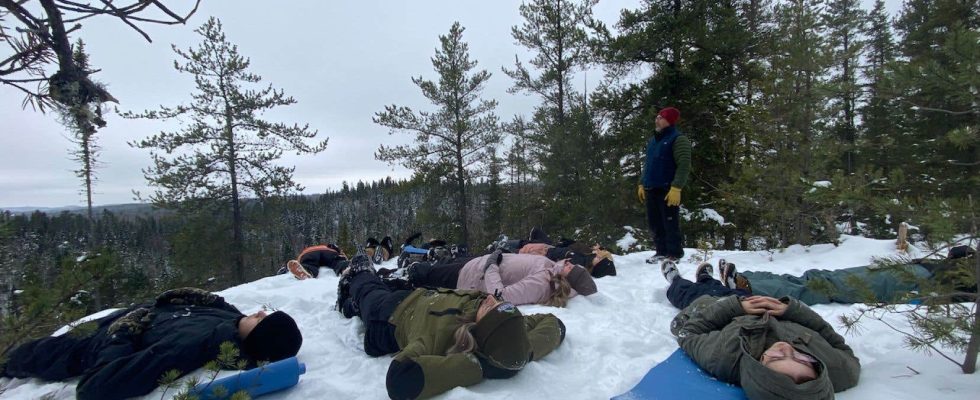This text is part of the special Culture Saguenay–Lac-Saint-Jean notebook
More than an inspiring environment due to its beauty, the territory of Saguenay–Lac-Saint-Jean transforms the practice of several artists and causes the cultural life of this region to evolve in a unique way.
For the artist who goes to Saguenay–Lac-Saint-Jean as part of a residency at the Bang contemporary art center, the kilometers he travels feel like the passage from one temporality to another, towards a different relationship with the world. “The road to our home is part of the artist’s reflective work,” says Patrick Moisan, general director of the center, which, in addition to dissemination and cultural mediation, welcomes artists over a long period of time and supports them in several spheres of their work in an intersectoral approach, that is to say by creating links between these artists and various environments, such as geology and agroforestry research. “Here, there is less pressure to perform, more slowness,” continues Mr. Moisan. We take artists where they are and support them at their own pace. »
A territory that transforms those who inhabit it
In residence at the Bang center, Mériol Lehmann, photographer and sound artist, spent a year working alongside the 150 acres of forest land acquired by the center as part of the KM3 project. “A true living laboratory, our project aims to initiate collective reflection on the forest of tomorrow and its uses by bringing together, around artists, actors from several sectors,” explains Mr. Moisan.
At the end of his immersive year, Lehmann saw his connection to nature move from an observant gaze to an intimate relational relationship, an experience with which resonates the author Julien Gravelle, who lives in the region and whose latest novel, IF, features characters each having a different relationship with the forest. “I am interested in what our environment says about us, in how the territory is expressed in the use of our bodies as we cross it, by canoe, by snowshoe, by walking,” says the writer.
If the author also reflects on the human propensity to want to control his environment, it is because, according to him, the idea that one must take root in a territory is particular to man, who wants “ hold boundaries against the forces of nature. “But, in my stories, the elements of nature are active, moving the story forward, and the characters are transformed by their environment. »
The Literary Forest, a project by author Charles Sagalane in the KM3 forest, embodies the dialogue between the territory and creation. The public, taking advantage of the benefits of sylvotherapy and in particular through in situ writing workshops, collaborates in a common artistic creation, “which becomes a territory that is both intimate and shared,” explains Patrick Moisan. This idea of experiencing the territory is also at the heart of Julien Gravelle’s reflections. “The boreal forest is a fragile but simple ecosystem. Quickly, we are able to find our way around, to have knowledge of our environment. This forest passes through me and always returns tirelessly in my writing. »
Forest Islanders
The effect of geographic isolation on artistic and cultural practices, Bernard Duchaine, vice-president of the board of directors of Objectif Scène, which brings together the region’s performing arts presenters, sees it in the collaboration between the actors who inhabit the territory. This regional partnership brings, he maintains, unique artistic results. “We are less influenced by what is done elsewhere. We are a species of Gauls, and the “rock of the lake” of artists Fred Fortin, Galaxie or Gab Bouchard is, among other things, a product of our remote territory. »
Isolated territory also rhymes with unique cultural events. In summer, on Repos Island, several events, such as the Les Denises du Lac festival, take place. And in the evening, “because our events are small, people stay up around the fire with the artists, which is not possible in large urban festivals! » mentions Bernard Duchaine.
Forest islanders, to use the words of Patrick Moisan, local stakeholders have a growing desire to remain in Saguenay–Lac-Saint-Jean, according to Mr. Duchaine. The region has in fact more than 2,500 workers in the cultural sector who have no other choice, to make a living from their practice, than to diversify. An actor will do theater, advertising, training in schools, for example. “We have fewer resources available,” concedes Bernard Duchaine, “but that leads us to manage, we become multitaskers. » The director of the contemporary art center Bang goes in the same direction. The great disciplinary diversity and the absence of cultural homogeneity “are due to our territorial reality”.
For his part, Julien Gravelle thinks that distance can sometimes be an obstacle to his professionalization. Also working with offenders, he often had to refuse invitations to literary conferences, which would involve taking several days off. “But I never question my choice to live here,” he says. Obviously, the territory of Saguenay–Lac-Saint-Jean is as much home to its artists and cultural workers as they are to it.
This content was produced by the Special Publications team at Duty, relating to marketing. The writing of the Duty did not take part.
